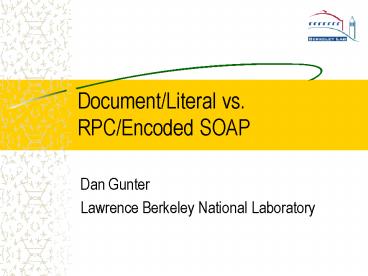Document/Literal vs. RPC/Encoded SOAP - PowerPoint PPT Presentation
1 / 14
Title:
Document/Literal vs. RPC/Encoded SOAP
Description:
1998: XML had no type system (no XML Schema), SOAP focused on providing one. Dave Winer invents XML-RPC using original SOAP type system ... – PowerPoint PPT presentation
Number of Views:87
Avg rating:3.0/5.0
Title: Document/Literal vs. RPC/Encoded SOAP
1
Document/Literal vs. RPC/Encoded SOAP
- Dan Gunter
- Lawrence Berkeley National Laboratory
2
Background - What is SOAP?
- Simple Object Access Protocol, but..
- Not really Simple
- Doesnt really Access Objects
- Not really a Protocol
- What is it really?
- A simple messaging framework for transferring
information specified in the form of an XML
infoset between an initial SOAP sender and an
ultimate SOAP receiver (SOAP 1.2 Primer) - SOAP 1.2 will not spell out the acronym.
(ibid.)
3
Very Brief history of SOAP
- From an article by Don Box 1
- 1998 XML had no type system (no XML Schema),
SOAP focused on providing one - Dave Winer invents XML-RPC using original SOAP
type system - 1999-2000 SOAP adds support for arrays and
references XML Schema still in flux - 2001-? SOAP also adopts XSD, providing two type
systems - Present SOAP Encoding is going away..
4
What is WSDL?
- Web Services Description Language
- Describes the message exchanges supported by Web
Services in an abstract way - May be bound to different underlying
transports, e.g. SOAP/HTTP, REST/HTTP, SMTP, - Most software I know of supports the SOAP/HTTP
binding
5
What is RPC/Encoded?
- Remote Procedure Call style invocation
- Changes the Fault elements slightly
- (WSDL 1.2) Each element in the input document
is a parameter - Top-level structure MUST be a sequence (no
choice) - SOAP Encoding
- Serialization of XML adds ID and HREF to allow a
directed graph (not just a tree) - Resulting XML document may no longer validate
against the XML Schema
6
RPC/Encoded WSDL (1.1)
- Input
- ltwsdlmessage name"DistanceInput"gt
- ltwsdlpart name"p1" type"tnsPoint" /gt
- ltwsdlpart name"p2" type"tnsPoint" /gt
- lt/wsdlmessagegt
- Output
- ltwsdlmessage name"DistanceOutput"gt
- ltwsdlpart name"result type"xsdfloat/gt
- lt/wsdlmessagegt
Perhaps XSD ltelementsgt in WSDL 2.0
7
RPC/Encoded SOAP
- Input
- ltsoapEnvelope ..gt
- ltsoapBody soapencodingStyle
- "http//schemas.xmlsoap.org/soap/encoding/
"gt - ltnsDistance ..gt
- ltp1 HREF"id1"/gt
- ltp2 HREF"id1"/gt
- lt/nsDistancegt
- ltnsPoint id"id1"gt
- ltxgt10lt/xgt
- ltygt20lt/ygt
- lt/nsPointgt
- lt/soapBodygt
- lt/soapEnvelopegt
Hmm, doesnt look much like a sequence of integer
elements!
8
What is Document/Literal?
- Document-style invocation
- Input is any XML document
- Output, if present, is another one
- Both are described with XML Schema (in theory,
other schema languages are supported) - Literal encoding
- The schema can validate the XML in the SOAP
request
9
Document/Literal WSDL (1.1)
..in theory, non-XSD schema languages can be used
- Input
- ltrncDistancegt
- distance p1 Point , p2 Point
- Point x xsdfloat, y xsdfloat
- lt/rncDistancegt
- ltwsdlmessage name"DistanceInput"gt
- ltwsdlpart namebody" typerncDistance" /gt
- lt/wsdlmessagegt
- Output
- ltwsdlmessage name"DistanceOutput"gt
- ltwsdlpart name"result" type"xsdfloat" /gt
- lt/wsdlmessagegt
10
Document/Literal SOAP
- Input
- ltsoapEnvelopegt
- ltsoapBodygt
- ltnsdistancegt
- ltp1gt
- ltxgt10lt/xgt ltygt20lt/ygt
- lt/p1gt
- ltp2gt
- ltxgt100lt/xgt ltygt200lt/ygt
- lt/p2gt
- lt/nsdistancegt
- lt/soapBodygt
- lt/soapEnvelopegt
Contents of soapBody will validate against the
schema
11
Schemas and Interoperability
- Schema validation provides a starting point
- Platform-independent, widely-implemented
- Note Schema validation is imperfect
- Slow as molasses
- Schemas can be brittle (especially if the schema
has a lot of datatype information) - Message validity ! Semantic validity
- Versioning not automatic
- But Better than eyeballing it!
12
What does this mean for NM-WG?
- Schemas have 3 uses
- Contracts Agreeing on structure of data
- Tooling Generate code stubs
- Validation Did I get what I wanted?
- The WG is dealing with 1
- In its full sense, 3 includes constraints not
expressible with schemas need informal or formal
specifications for this - E.g., if user is requesting a UDP measurement,
ignore TCP parameters
13
Additional thoughts..
- Schemas are good for describing the shape of an
XML document, but data types may be overkill - Especially if youre using a language like Perl
or Python - Many useful constraints are still hard to
express - If packetType is UDP, ignore numStreams
- Note that data-types may inadvertently make life
harder - Need something like XSLT to evaluate
co-occurrence constraints? - All the tools are, at best, first-generation
14
References
- http//webservices.xml.com/pub/a/ws/2001/04/04/soa
p.html































